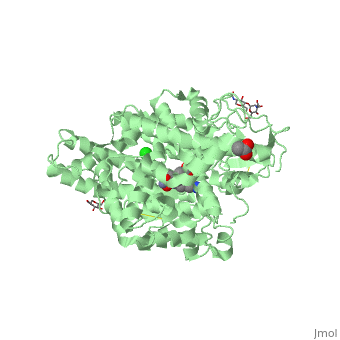2c6n
From Proteopedia
Structure of human somatic angiontensin-I converting enzyme N domain with lisinopril
Structural highlights
DiseaseACE_HUMAN Genetic variations in ACE may be a cause of susceptibility to ischemic stroke (ISCHSTR) [MIM:601367; also known as cerebrovascular accident or cerebral infarction. A stroke is an acute neurologic event leading to death of neural tissue of the brain and resulting in loss of motor, sensory and/or cognitive function. Ischemic strokes, resulting from vascular occlusion, is considered to be a highly complex disease consisting of a group of heterogeneous disorders with multiple genetic and environmental risk factors.[1] Defects in ACE are a cause of renal tubular dysgenesis (RTD) [MIM:267430. RTD is an autosomal recessive severe disorder of renal tubular development characterized by persistent fetal anuria and perinatal death, probably due to pulmonary hypoplasia from early-onset oligohydramnios (the Potter phenotype).[2] Genetic variations in ACE are associated with susceptibility to microvascular complications of diabetes type 3 (MVCD3) [MIM:612624. These are pathological conditions that develop in numerous tissues and organs as a consequence of diabetes mellitus. They include diabetic retinopathy, diabetic nephropathy leading to end-stage renal disease, and diabetic neuropathy. Diabetic retinopathy remains the major cause of new-onset blindness among diabetic adults. It is characterized by vascular permeability and increased tissue ischemia and angiogenesis. Defects in ACE are a cause of susceptibility to intracerebral hemorrhage (ICH) [MIM:614519. A pathological condition characterized by bleeding into one or both cerebral hemispheres including the basal ganglia and the cerebral cortex. It is often associated with hypertension and craniocerebral trauma. Intracerebral bleeding is a common cause of stroke.[3] FunctionACE_HUMAN Converts angiotensin I to angiotensin II by release of the terminal His-Leu, this results in an increase of the vasoconstrictor activity of angiotensin. Also able to inactivate bradykinin, a potent vasodilator. Has also a glycosidase activity which releases GPI-anchored proteins from the membrane by cleaving the mannose linkage in the GPI moiety. Evolutionary ConservationCheck, as determined by ConSurfDB. You may read the explanation of the method and the full data available from ConSurf. Publication Abstract from PubMedHuman somatic angiotensin I-converting enzyme (sACE) is a key regulator of blood pressure and an important drug target for combating cardiovascular and renal disease. sACE comprises two homologous metallopeptidase domains, N and C, joined by an inter-domain linker. Both domains are capable of cleaving the two hemoregulatory peptides angiotensin I and bradykinin, but differ in their affinities for a range of other substrates and inhibitors. Previously we determined the structure of testis ACE (C domain); here we present the crystal structure of the N domain of sACE (both in the presence and absence of the antihypertensive drug lisinopril) in order to aid the understanding of how these two domains differ in specificity and function. In addition, the structure of most of the inter-domain linker allows us to propose relative domain positions for sACE that may contribute to the domain cooperativity. The structure now provides a platform for the design of "domain-specific" second-generation ACE inhibitors. Crystal structure of the N domain of human somatic angiotensin I-converting enzyme provides a structural basis for domain-specific inhibitor design.,Corradi HR, Schwager SL, Nchinda AT, Sturrock ED, Acharya KR J Mol Biol. 2006 Mar 31;357(3):964-74. Epub 2006 Jan 31. PMID:16476442[4] From MEDLINE®/PubMed®, a database of the U.S. National Library of Medicine. See AlsoReferences
| ||||||||||||||||||||


